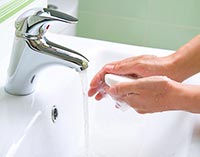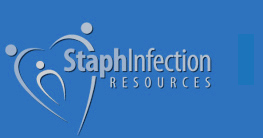How do you get Staph or MRSA? What are the Risks?

You can catch MRSA or Staph by getting these bacteria inside your body through cuts, scrapes or even tiny openings like hair follicles.
How do skin infections get started?
People get infected with Staph or MRSA skin infections in the following two steps:
- Coming into contact with objects or people who are contaminated with MRSA or Staph bacteria. People can spread bacteria to you if they are infected or if they are a MRSA/Staph carrier. However, casual contact is usually not enough to cause an infection. To actually get infected usually requires step 2 below.
- Passing the bacteria through your skin. An actual infection can only start after the bacteria get INSIDE your body. The most common ways these bacteria infect your skin include:
– Through a puncture in your skin (cut, razor burn, scrape or needle puncture).
– Through an existing cut or wound becoming contaminated with the bacteria.
– By invading small openings in your skin like hair follicles (causing folliculitis).
How do you catch Staph nose infections?
Staph nose infections can start the same way as skin infections: through abrasions in the skin or though hair follicles. They can also occur after colds, flu or surgery when the nasal membranes are inflamed or damaged. Researchers aren’t entirely sure how nose infections get started, but they have found a protein that Staph aureus bacteria make which binds them to human skin cells1 (see “Are Staph living in your nose?”).
Click here for common skin infection symptoms and pictures. Read on below for ways to reduce your risk of infection.
How do internal infections get started?
Lancing or squeezing skin boils or other skin infections at home can push infections internally. Dirty catheters or improper hygiene can cause MRSA urinary tract infections as well. Also, wounds that become contaminated can also lead to internal infections.
However, most people get internal infections through hospital procedures which introduce MRSA and Staph bacteria inside the body.
- Skin infections can be caused by contaminated surgical instruments or room air.
- More dangerous blood or bone infections can be caused by contaminated medical implants and contaminated metal screws or plates.
- Contaminated medical instruments like ventilators and bladder catheters can also cause infection (see Hospital Risks below).
Risk factors: Community, personal and hospitals
Where can you encounter MRSA and Staph? The easiest places to get exposed to these bacteria are hospitals, nursing homes and other healthcare facilities. They have long been the number one place to come into contact with Staph or MRSA bacteria. However, crowded public places are rapidly causing more and more infections.
Note: Because MRSA is a type of Staph infection, you can get Staph or MRSA infections the same way. MRSA is more dangerous because it is resistant to many antibiotics, making it very challenging to treat. To learn more about treatment options, click here.
Community and public risks

Community MRSA can be found in many public places. Shopping cart handles are one “high-touch” surface where MRSA can lurk.
While MRSA and most other so-called “superbugs” got their start in hospitals, the fastest growing area of risk is in our communities. Because MRSA and Staph bacteria come from people, any place with lots of people in close quarters or where lots of people contact objects and surfaces can be a breeding ground for all kinds of bacteria, including Staph and MRSA.
Here are some common places MRSA and Staph can be found in the community:
- Day care facilities, schools and college campuses
- Homeless shelters
- Shopping centers
- Public transportation (buses, taxi cabs and airplanes)
- Prisons
- Gyms
- Military barracks
- Amusement parks
- Pools, hot tubs and even the beach sand and surrounding fresh or salt water
Common community infection types
Community-caused Staph and MRSA are usually limited to different types of skin infections like:
- Boils, abscesses and cellulitis.
- Skin infections can move inside the body and be much more dangerous. MRSA from the community can also cause sinus infections, eye and ear infections.
- You can also get painful sores in your nose.
See below for ways to reduce your risks of exposure and your risk of infection.
Personal activity risks

Sharing personal products like towels, bath sponges and deodorants increase your risk of getting MRSA or Staph, especially if the owner is infected or is a carrier.
There are several activities that can increase your chances of being exposed to MRSA or Staph. And, there are also several conditions that make your body more prone to infections, regardless of other risk factors or activities.
If any of the activities or conditions below describes you, taking extra precautions is a good idea (see below), especially in high-risk environments.
Activities that can increase your risk of being exposed to MRSA or Staph include:
- Sharing clothing or sports equipment
- Sharing personal items like razors or towels
- Having intercourse with someone who’s infected
- Taking antibiotics for Staph infections that don’t work can increase your chances of getting MRSA
- Puncturing your skin with needles or intravenous drug use
- Tattoos
- Poor skin hygiene
- Contact sports in schools and on professional teams
- Caring for infected family members or friends
In particular, playing contact sports and using shared sports equipment is a significant risk factor. There have been many cases of Staph and MRSA outbreaks reported in the news lately, including inside NBA, NFL and other major sports teams, as well as high school and college teams.
Conditions that can make you more prone to infection include:
- Being a MRSA or Staph carrier
- Skin injuries or history of skin infections
- Poor diet
- Low immunity due to underlying illness, stress or lack of sleep
- Diabetes and obesity
- A weakened immune system (cancer, HIV positive), taking immuno-suppression drugs (organ transplant patients), or taking medications that make you more vulnerable to infection2
- Newborns and the elderly
Hospital and healthcare risks

MRSA and Staph are very common in hospitals. You can find these bacteria on high-touch places like bed rails, IV stands, monitors, curtains, sink areas and even in the air.
Hospitals are where superbugs like MRSA were created, and it’s still the most common place to catch these infections. A recent hospital visit, either as an inpatient or just visiting someone, is a good way to exposure yourself. Beyond hospitals, doctor clinics, diagnostic centers and mobile stations can also harbor infecting bacteria.
The most common ways to catch MRSA Staph in healthcare environments are listed below.
- Contaminated medical instruments and devices like metal or silicone implants (internal and skin infections)
- Catheters (bladder infections)
- Pic lines or IV needles (internal or blood infections)
- Needle punctures from vaccinations or injections (skin or internal infection)
- Improperly maintained MRI scanning units (skin infections)
- Improperly maintained medical instruments like respirators. Infections can be picked up by inhaling the bacteria into your lungs (pneumonia)
- Surgical procedures (incision site infection), or contaminated surgical implants (artificial knees, etc)
- Airborne MRSA (a controversial issue which has been proven to cause skin colonization, infection or pneumonia. Click here for airborne MRSA info.
- Your hospital roommate is a MRSA carrier, or has active an MRSA infection (see below)
Internal infections (blood, bone, bladder, pneumonia, etc) are most often obtained at healthcare facilities, though you can still get skin infections from surgical site incisions. You can find out more about hospital type infections and how to protect yourself against them on our preventing healthcare infections page.
A warning about shared hospital rooms
We hear from many people who shared hospital rooms with people who had active MRSA infections. To this day, many hospitals do not separate infected patients from non-infected. They won’t tell you that your neighbor has MRSA either. This is an unfortunate practice as it greatly increases your risk of getting MRSA because there will be more MRSA bacteria in your room, both on surfaces and in the air.
Effective hygiene practices and additional steps you can take for controlling MRSA in the air will help reduce your chances of getting infected.
Reducing your risk of infection

Good hand hygiene is one of the best ways to reduce your chances of an infection.
There’s no need to avoid going out in the community, being with your friends or co-workers, or playing your favorite sport. Being aware of activities that can expose yourself to these bacteria, and how infection starts are the first steps, as covered above. Taking a few simple precautions can greatly reduce your risk of becoming infected.
The easiest and best thing you can do to reduce your chances of infection is wash your hands. Proper hand washing and good hygiene go a long way to reducing bacteria you’ve touched when out in public or from touching other people. Also, when you are out and about, avoid touching your face until you’ve washed your hands. Staph and MRSA love to inhabit your humid and moist nose, so keep your fingers away until they’re clean. You can also carry a hand sanitizer to use when you can’t wash your hands with soap and water.
Taking a shower before and after using pools, beaches, and contact sports will also reduce bacteria on your body you picked up from other people or equipment.
For much more on prevention techniques, hand washing, disinfection and cleaning and dealing with airborne bacteria, see our prevention section here.
Can I catch MRSA from surfaces in my home or in the air? Yes. Staph or MRSA are commonly transferred from contaminated surfaces and objects. If someone in your home is infected, MRSA can be on surfaces or in the air. Think of any surface people touch and these are higher risk surfaces. Examples can include: door knobs, toilet handles, toys, remote controls, cell phones, mp3 players, and keyboards. Research has also proven that MRSA and Staph organisms can pass through the air on dust and skin particulates.
I was with a friend who had MRSA – will I get it too? Just because you have been exposed to these bacteria, it does not mean you will get infected. We often hear from concerned moms and family members that they just found out a friend was infected, and they are rightly concerned about their own safety. So, being exposed to them doesn’t mean or guarantee you will get infected.
Can I get MRSA from my pet? Yes, but MRSA is more commonly transmitted TO pets from their human owners rather than the other way around. Pets do not normally carry these specific bacteria on their bodies. However, just like people, dogs and cats who are exposed to the bacteria can be carriers of Staph or MRSA without being infected themselves. While less common, pets can and do sometimes get infected with MRSA. In either case, pets can pass along these bacteria to people who can either become carriers themselves, or become infected.
If I have MRSA, can I give it to my husband during intercourse? MRSA and Staph have a tendency to live on moist and warm areas of the body, which includes the armpits, nose and groin area. Because the bacteria can spread from direct touch and infections are contagious, intercourse is a risk for a person to be exposed to Staph or MRSA bacteria.

- How contagious is MRSA?
- MRSA Carriers don’t show symptoms – Find out what a carrier is
- What are the signs and symptoms of an infection?
- Prevention techniques overview (cleaning, disinfection, airborne routes of transmission and more)
References:
1. Mulcahy ME, Geoghegan JA, Monk IR, O’Keeffe KM, Walsh EJ, et al. (2012) Nasal Colonisation by Staphylococcus aureus Depends upon Clumping Factor B Binding to the Squamous Epithelial Cell Envelope Protein Loricrin. PLoS Pathog 8(12): e1003092. doi:10.1371/journal.ppat.1003092
2. Who is at risk for Staph infections? Medicinenet.com




